Ferny Ness crash, 27th April, 1943
Ferny Ness is a small promontory reaching into the Firth of Forth near Longniddry and abutting the western edge of Gosford Sands. Nowadays it is a popular spot for coastal visits, a place where vehicles are parked and families explore the shoreline and the surrounding area. The long-distance path, the John Muir Way, passes along its edge. Some sources have spelt it Fernieness, claiming this was an attempt to confuse the Germans. I rather doubt that: such a simple alteration in spelling wouldn't confuse for long!
Whatever its spelling, it was at Ferny Ness that East Lothian experienced its highest wartime loss of life in a single event.
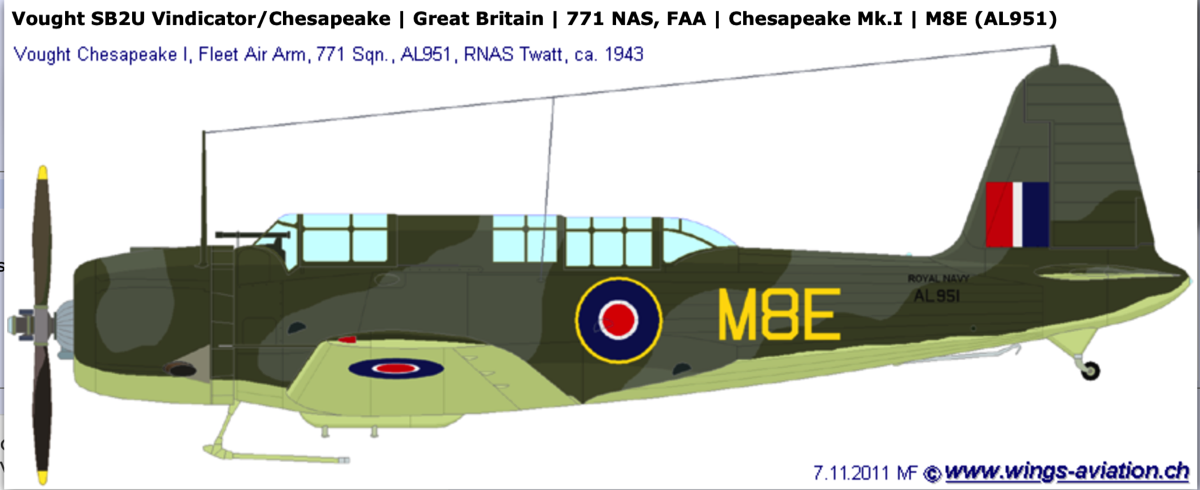
The aircraft involved in the accident was a pre-war American design which was relegated to a training role in both the US and the Fleet Air Arm by 1941. The particular version used by the FAA was the SB2U. This was originally thought to be suitable for carrier operations but it was quickly decided that the aircraft was underpowered and unsuitable for that purpose. By 1943, this was a relatively obsolete design.

Naval ratings under instruction at a DEM training site near Liverpool.
Training at Ferny Ness would have been just like this.
[Used under common licence from the Imperial War Museum]
Ferny Ness was used for two distinct purposes during the war. First as a Naval Gunnery Practice Range where naval personnel and others could be trained in the use of the smaller artillery pieces carried on DEMS, Defensively Equipped Merchant Ships. These would have included anything from 3" - 4" guns, sited on the stern or bow, and a variety of anti-aircraft guns such as Lewis guns or even Oerlikon cannon. Significant numbers of merchant seamen, naval ratings and members of the Maritime Royal Artillery were trained to use such artillery pieces and were employed to man them on merchant ships.
Training establishments could be found all over the UK from HMS President on the Thames and HMS Eaglet in Liverpool to HMS Caroline in Belfast. Perhaps of interest, HMS Caroline, a First World War Cruiser, was the second oldest ship in the navy after HMS Victory at the time of its decommissioning in 2012. Given its geographical proximity, it is possible, though as yet unproven, that the work at Ferny Ness was linked to that carried out through the shore station, HMS Claverhouse, situated in Granton, Edinburgh. The 2nd Regiment, Maritime Royal Artillery was based in Leslie and was tasked with the defence of the Forth. Mr William Poundall joined the 2nd Regiment, MRA, in August 1943, and interestingly wrote that he did his training in Musselburgh.
Secondly, the surrounding sea was used by the Fleet Air Arm for dive-bombing practise, especially by aircraft from the various training squadrons based just across the Forth at HMS Jackdaw, otherwise RNAS Crail, Fife Ness. This was an extremely busy airfield with over two hundred aircraft based there both from training and from front line squadrons.

A scene setting photograph of Ferny Ness.
The concrete slab may well be the remains of a small calibre gun platform.
Sub. Lt. Kenneth Roy Joll, R.N.V.R., from Northampton, took off in Chesapeake AL938, probably from FAA Crail where his training squadron, 770, was based, to practise dive-bombing at the Ferny Ness range. His fellow crewman in the rear was Telegraphist Air Gunner Acting Leading Seaman Robert Hartley, FX86655 from Hull. Weather conditions appear to have been unremarkable. AL938's other footprint in history was to have been used in 1942 for carbon monoxide contamination tests at FAA Crail.
Joll flew the short distance south west to Ferny Ness where he began his practise dives. We know that he made at least two, successfully pulling out of the first but failing to do so the second time. While he was flying, a party of thirty-five Naval Ratings and Merchant Seamen was preparing to go home after a day's training at the range. David Mathieson, 19 Deanpark Street, Edinburgh, had the engine of his S.M.T. bus running, ready to take them home and his passengers were in the act of getting aboard his bus. While half were aboard and half still outside, the Chesapeake hit the ground in front of the bus and bounced into it.
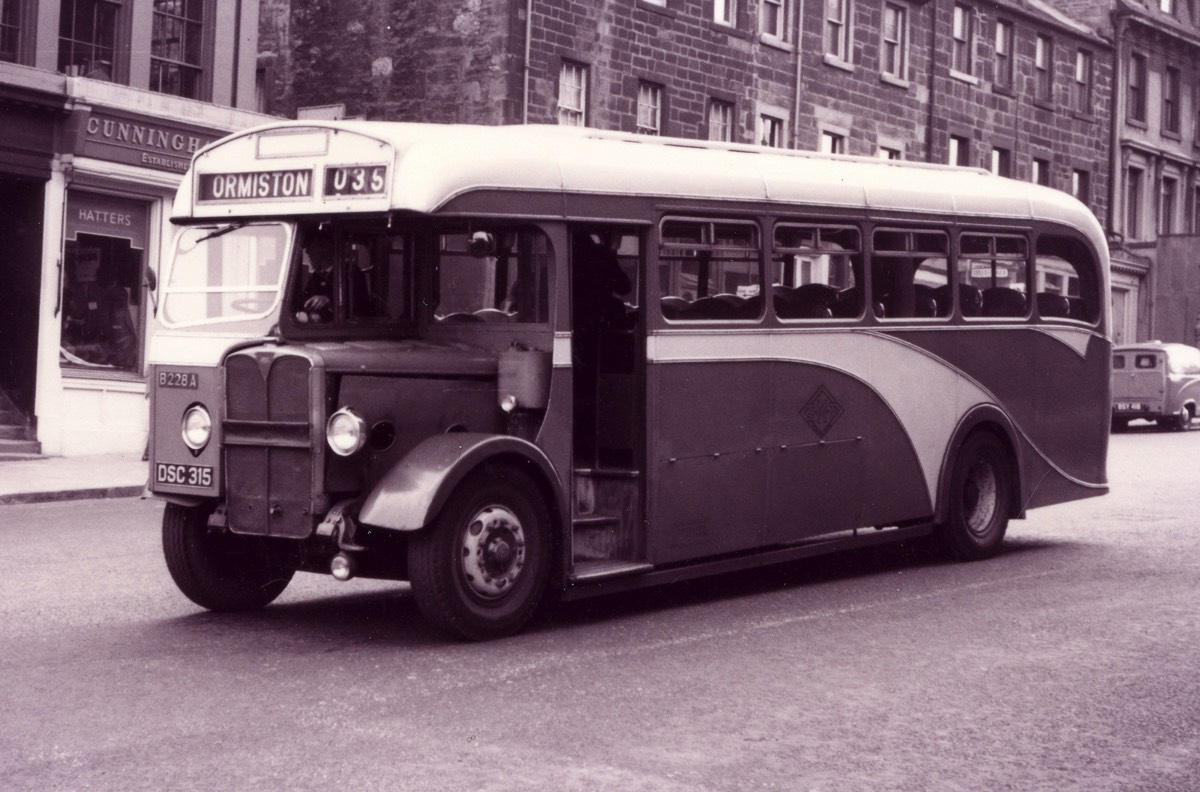
The bus involved in the crash was probably DSC 312, an AEC Regal, similar in almost all respects to the one shown above (DSC 315). DSC 312 was bought new in 1940 and scrapped in April 1943, 'after an accident'.
My thanks to Graham Martin Bates of the Scottish Vintage Bus Museum who uncovered these details and this photograph from the collection of the late Neil Pollard.
In the shocked aftermath, those men not killed instantly scrambled to get away from the flames or to escape the interior of the bus. Those uninjured did their best to help and rescued six who were suffering from burns, while twelve managed to smash their way out through the windows of the bus and escape. The intense heat soon made further rescue attempts impossible.
In all we believed that fourteen died: both aircrew; David Mathieson, the driver; nine Ratings and two merchant seamen. At least two of them died en route to hospital in the immediate aftermath of the crash. However, recent information has come to light which alters this number. See further below.
The initial list of casualties included:
Aircrew
Sub. Lt. Kenneth Ray Joll, R.N.V.R, buried in Hull Northern Cemetery
Acting Leading Seaman Robert Hartley, buried in Abington (SS Peter and Paul) Church
Royal Navy
Act. AB Earnest Beswick, 25, C/JX 223520, buried in Edinburgh (Seafield) Cemetery
Act. AB David Brookes, 20, D/JX 338095, buried in Edinburgh (Seafield) Cemetery
Act. AB Ernest George Carr, 23, P/JX 201363, buried in Edinburgh (Seafield) Cemetery
Act. AB Patrick Curran, 30, D/JX337908, buried in Edinburgh (Seafield) Cemetery
Act. AB Leslie J. Dodson, 23, P/JX 289242, buried in Gosport (Ann's Hill) Cemetery
Act. AB Patrick Kennan, 28, P/C/DX 2230, buried in Edinburgh (Seafield) Cemetery
Act. AB Walter Laverack, 28, C/JX 262492, buried in Rawcliffe Cemetery
Act. AB John MacLeod, 30, C/JX289681, buried in Edinburgh (Seafield) Cemetery
Act. AB Alexander Rudd, 20, P/JX 334136, buried in Frizington (St Paul) Churchyard
Merchant Navy
AB George Alan Osburn, 36 of the SS Rother (Goole)
Greaser Stephen Thacker, 23 of the SS Rother (Goole)
Civilian
David Mathieson, Edinburgh, driver with fifteen years service with S.M.T.
[My thanks to Kieron Hill and WW2 Talk plus naval-history.net for confirmation of details.]
However, I have been contacted by two correspondents who have introduced intriguing additional findings to the story. First, Paul Allonby, a military historian from Derbyshire, found mention of an addition naval casualty, that of Act/Able Seaman William Gibson (DEMS), P/JX 261576 from HMS (?) President III, O/P. This is mentioned in the website https://www.naval-history.net/xDKCas1943-04APR.htm
Second, Carol Follett wrote to explain that a third Merchant Marine from the SS Rother was killed in the bus. She wrote: "The only two seamen listed were SS Rother crewmen. My father's youngest brother, just turned twenty, was also killed on the bus in Ferny Ness. He was a Merchant Marine from Michigan [USA]. The 'The 1943 Ferny Ness plane and bus crash - a wartime disaster - Your Tube' video includes his name, although it is incorrectly spelled 'Lewis' instead of 'Louis'." This is corroborated by Paul Allonby, who included the following photograph from the Grimsby evening Telegraph, 30th April, 1943.
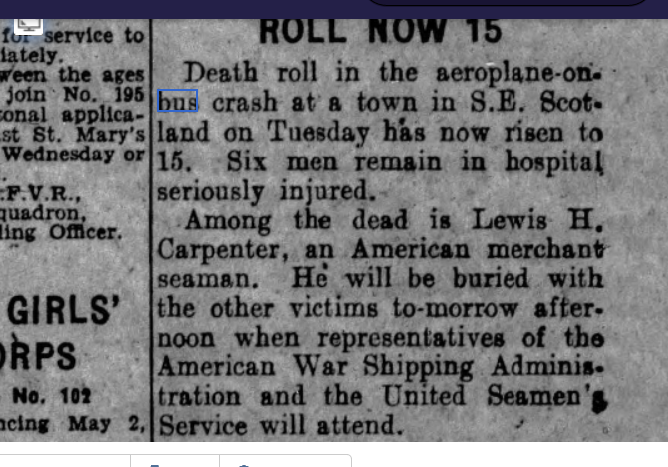
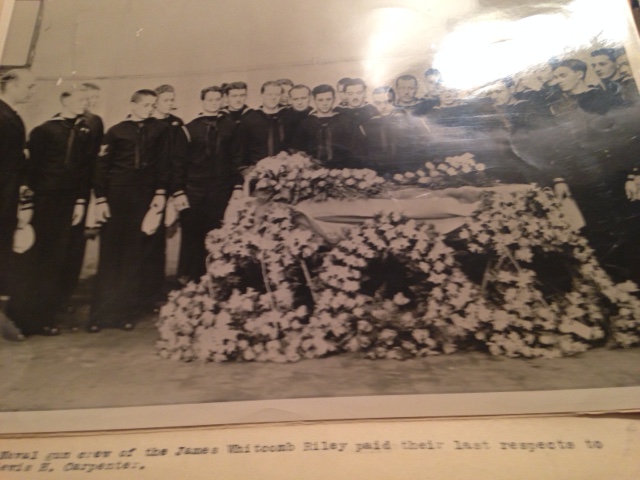
My apologies for the reflections on this photograph. However, the photograph does tend to raise the question that Louis Carpenter may well have been a crewmember on board the James Whitcomb Riley at the time of the Ferny Ness disaster.
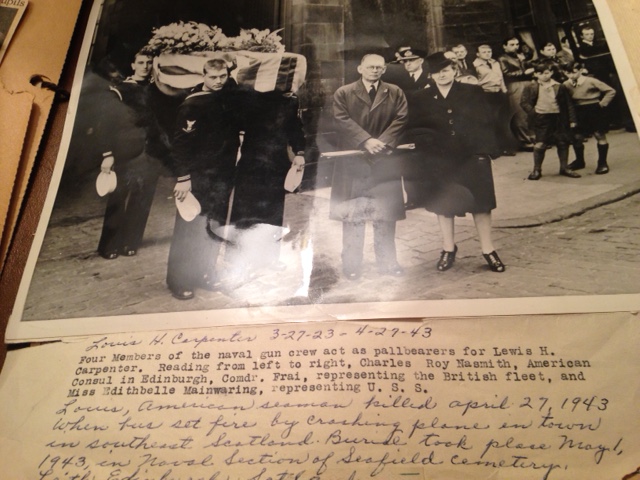
Carol Follett's photograph of Louis Carpenter's funeral and interesting information beneath.

Louis Carpenter's gravestone in Michigan.
We are thus left with the likely conclusion that sixteen men died in the Ferny Ness disaster, not thirteen, as mentioned on the commemorative plaque by the Royal British Legion in Longniddry.

The SS Rother, launched on the Clyde in 1914 and scrapped on the Tyne in 1956.
Both George Osburn and Stephen Thacker were members of its crew. Louis Carpenter may have been a third member of its crew.
The site staff and those uninjured gave what First Aid they could to the survivors. Alerted by the sound of the crash, ambulances from a Polish Red Cross station nearby at Gosford Camp, arrived to render assistance and to transport casualties, first to the Polish Red Cross hospital at Gosford and then to other hospitals in the region. It is known, for example, that one of the casualties, Stephen Thacker, died on the 30th April at Astley Ainslie Hospital, Grange Loan, Edinburgh.
The area itself was a scene of devastation, described by a witness, Mr Scott, as reminding him of his experiences at the Battle of Arras in 1917.
An Eye-witness account: Peter Craig Leslie, Lothian Civil Defence Officer, 35, Longniddry.
Peter Leslie witnessed the crash and rendered timely First Aid to the casualties. In his report to his superiors he wrote:
"Shortly before 1600 hours on Tuesday 27th April 1943 I was proceeding by car westwards on the Coast Road between Aberlady and Longniddry. On approaching the Naval Gunnery Practice Range at Ferny Ness, Longniddry, I observed that practise dive bombing was in progress and drew into the south side of the road and stopped facing westwards to the demonstration.
I saw the aircraft in one dive from south to north over the range and a few minutes later the same aircraft gave a second demonstration dive flying from west to east. As the aircraft approached the Gunnery Range I saw it dive and for some reason the Pilot appeared unable to pull out of the dive.
The aircraft struck the ground and bounced off crashing into a stationary S.M.T. bus standing within the enclosed Gunnery Range. The aircraft was completely wrecked and parts were strewn over a distance of approximately 100 yards over the Range.
The bus caught fire and was quickly enveloped in flames. A small hut nearby also caught fire. [Two naval personnel described being knocked to the ground in this hut and managing to escape in the smoke and flames]
I ran towards the burning bus and found two men whose clothes were blazing. I smothered the flames with a coat. …
Many of the naval personnel were [seriously injured] and it was apparent that a number who were seriously injured would require immediate attention. I therefore hastened to the Police Station, Longniddry, and requested the Constable on duty to summon the Fire Brigade, doctors and ambulances.
Immediately thereafter I returned to the scene of the incident accompanied by the Constable and rendered First Aid to the injured men many of whom had sustained compound fractures to both legs and severe head injuries. All were suffering from severe shock.
Later I asked a number of soldiers to help me place the injured men in an army vehicle and I went with the injured to Gosford Military Camp, Aberlady. When I returned from the military camp to Ferny Ness the National Fire Service pump from Haddington was in attendance.
I made a further search of the Range and found a number of men in sailor's uniform … presumably dead as well as a body in S.M.T. uniform, thought to be the driver of the bus. There were also discovered two bodies in flying kit believed to have been the occupants of the aircraft. …
An RAF ambulance arrived some considerable time afterwards and I assisted the attendants to collect and load the bodies into the ambulance. With the assistance of the National Fire Service personnel from Haddington I recovered two dead … from the vicinity of the bus and one … from the wreckage of the bus itself.
From enquiries made later it seems that no provision had been made at the Gunnery Range to render First Aid and there did not appear to be any person at the Range qualified in First Aid measures.
Further there appeared to be considerable delay in the appearance of assistance in the form of First Aid personnel and an ambulance. This did not arrive until after the injured men had all been taken away in army vehicles to Gosford Military Camp."
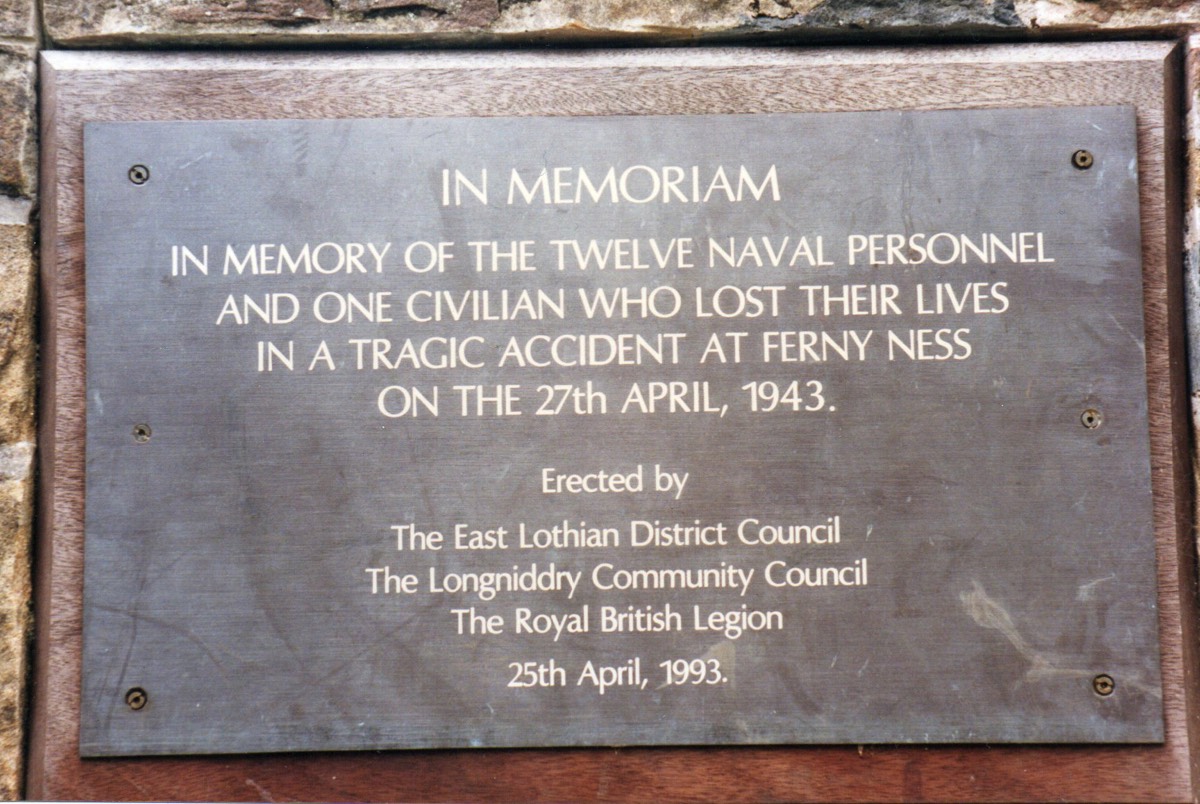
This simple memorial plaque can be found in Longniddry on the wall by the local branch of the Royal British Legion. There is no memorial at Ferny Ness itself.

